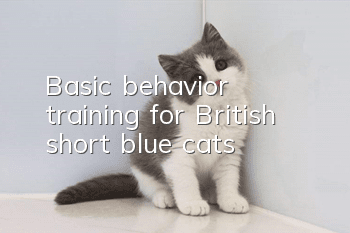How to train a Fold-eared cat? Training tips for Fold-eared cats!

Scottish Fold cat (detailed introduction)
How to train a Fold cat? Fold cat training tips! Most Fold cats are well-behaved and obedient, but some Fold cats are born with it He is a destructive person, grinding his claws, urinating indiscriminately, being aggressive towards others, etc. It gives owners a headache. In fact, dogs are not the only ones who accept training from their owners. Training Fold-eared cats is not that difficult if you use the right method. Let’s read the following article. I hope it will be helpful to train Fold-eared cats.
1. What to do if a folded-eared cat behaves aggressively
1. If it is a lonely old cat, you might as well add a kitten to accompany it. It keeps company. Because it is easier for an old cat and a young person to accept each other, but it should be noted that the kitten has to be brought home by someone the old cat never knows. This person is there in the hope that the old cat will not associate you with the kitten and become jealous.
2. If the old cat is hostile to the kitten, you might as well call the kitten "the old cat's kitten", because this can create a positive connection between them. Secondly, when talking to the kitten, you should also talk to the old cat at the same time, so that the old cat is involved and has normal contact with the kitten, so as to cultivate the relationship between them.
3. If a cat is particularly nervous about someone, you might as well refer to that person as the cat's person, such as "This is the cat's Lily, it is Lily's cat." Keep them connected. This will dispel the cat's nervousness and anxiety about this person, but it needs to be practiced repeatedly.
4. Cats are easily affected by their owners’ emotions. As an owner, you should do more exercises and activities to reduce stress so that both you and the cat can relax.
5. Some owners will go to the pet hospital and use sedatives to control their cats’ emotions. However, if they simply try sedatives, this is a temporary solution rather than a permanent solution; to be effective, the cat’s behavior must be rebuilt and Supplemented with sedatives, this can help the cat reduce the behavior that triggers its aggression.
6. Music also has a relaxing effect on cats and can reduce their aggressive behavior. Therefore, you can play your music with soft background music, which can also soothe cats.
7. When a cat feels nervous, it will naturally use its claws to attack its enemies, so you need to trim your cat’s nails frequently. When trimming, it is best to have another person hold it. , to draw its attention.
In short, the aggressive behavior of folded-eared cats is mostly caused by emotional stimulation, so owners should avoid anything that may affect the cat’s mood. Don't punish your cat for aggressive behavior. Punishing a cat has the potential to add stress and make the cat more aggressive. It’s important to note that cat aggression can sometimes be a serious problem. If you feel that things are getting out of control, contact your veterinarian immediately and ask him to help you consult a domestic cat behavior expert.
2. Tips for training fold-eared cats
1. The importance of early socialization
Since cats live in a relatively closed environment and have less contact with the outside world, cat owners must arrange sufficient and pleasant social opportunities for cats when they are young. , let it coexist harmoniously with people or other animals with a healthy attitude. The period from 2 weeks to 7 weeks of age for cats is a sensitive period for socialization. Socializing kittens early can prevent behavioral problems in adulthood, and establishing good habits is much easier than correcting bad ones later.
2. Adapt to family life at an early age
From the age of two weeks, cats should be caressed by their owners, several times a day for a few minutes at a time, and gradually increase the time and density of caressing. . While petting, talk to the cat gently. If possible, relatives and friends should be invited to pet the cat together, or the owner should put on a hat, sunglasses or other disguises to allow the cat to adapt to a different image.
During this period, the cat will be weaned and start eating solid food. They will gradually begin to explore the things around them, increase their play time, increasingly show strong curiosity, and their movements will become more and more coordinated. The owner should seize this opportunity to give it a full life experience and reduce its fear of strange things.
Gradually introduce noisy vacuum cleaners, washing machines, doorbells and other daily necessities to cats to help them adapt to the home environment. They should also feel the sound of dogs barking and car horns frequently.
3. Don’t be too proactive
Cats are independent animals, so don’t be too proactive when making friends with cats. If your cat has missed the best socialization period, or has had an unpleasant experience that left a psychological shadow, you should only approach your cat when it is very relaxed. You can let the cat understand your kindness by talking to it softly while it is eating. The above caressing method is also effective, but do not rush to touch it, make loud noises, or move too violently to scare the cat. A patient and gentle attitude will definitely win your cat's favor and trust.
4. Teach students in accordance with their aptitude
Each cat has a different personality, hobbies and living habits. Some cats are lively and active and like to explore at home; some cats are sweet lovers and like to act coquettishly in the arms of their owners; and some cats are more willing to be alone... Different cats are fascinated by different toys. Once you understand the characteristics of cats, you can plan your daily activities in a targeted manner, and the process of understanding cats is also very interesting for owners.
5. Punishment is useless
Cats are arrogant by nature, and punishment has little effect in raising good cats. Punishment afterwards is even more harmful than helpful, because the cat will not associate the previous wrong behavior with the subsequent punishment, but will be confused by the owner's attitude. Hitting and scolding at will will destroy the cat's affection and trust in the owner. Therefore, when the cat does something wrong, a timely "No!" can help the cat understand the owner's likes and dislikes.
With patience, care and scientific methods, you will definitely be able to create a cute cat that makes you proud. And flatA quiet and confident personality can also allow cats to experience more fun in life, thereby allowing cats to live in harmony with humans better.
3. Use aversion techniques to train Fold-eared cats
It is very effective to stop Fold-eared cats when they first show signs of bad behavior. of. If he starts flapping at the leaves of your houseplants or the cords of your electronic appliances, that's a sign that he's ready to chew, and it's time to stop him - nip the bad behavior in the bud and say, "No!" , "Go!", the voice should be loud enough to make it stop what it is doing to look at you or scare it away. After it runs away and sits quietly, you can go over and encourage it.
If you scare it into running away or hiding, never chase it or force it back to punish it. This will only confuse and scare it. When he shows up again, tell him what you want him to do: No, not jump on the kitchen table, but what about this tall, cute cat jungle gym? Wait until he jumps on the cat jungle gym on his own. Give it some encouragement.
If possible, you can adopt a "replacement" strategy, using a cat climbing frame instead of the top of the refrigerator, a cat scratching board instead of the sofa, and an old sock tied in knots for grinding teeth instead of wires. . Behaviors such as claw sharpening and biting are cats' instincts and are inherited from generation to generation. It is impossible to completely eradicate them. Therefore, you need to find some appropriate solution to reach a compromise between you and your cat.
When training a Fold-eared cat, if yelling at the Fold-eared cat loudly or replacing strategies does not work, you can use the "antipathy technique". When the Fold-eared cat scratches the sofa, spray it with a water gun or watering can, so that it can associate the unpleasant feeling of being sprayed with water with the action of scratching the sofa. You can also put a few coins in an empty tin can, cover it with the lid, and shake the tin can next to it every time you find it wants to jump on the dining table. The noise produced will be enough to scare it away. Repeat this several times and it will get rid of it. I can remember it.
- Will Ragdoll cats’ fur become darker in winter?
- What kind of special litter box should be prepared for pet cats?
- Why do cats eat dead leaves?
- Is it good to neuter male cats?
- Is it okay for cats to eat one kind of cat food for a long time?
- Will impure folded-eared cats get sick?
- Do cats cry after being abandoned?
- Symptoms and treatments for spontaneous cystitis in cats
- Can hair in a cat's eye come out on its own?
- How to change a timid cat?



